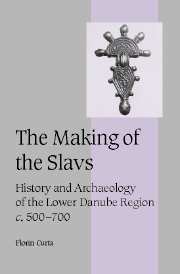Book contents
- Frontmatter
- Contents
- List of figures
- List of tables
- Acknowledgments
- List of abbreviations
- Introduction
- 1 Slavic ethnicity and the ethnie of the Slavs: concepts and approaches
- 2 Sources for the history of the early Slavs (c. 500–700)
- 3 The Slavs in early medieval sources (c. 500–700)
- 4 The Balkans and the Danube limes during the sixth and seventh centuries
- 5 Barbarians on the sixth-century Danube frontier: an archaeological survey
- 6 Elites and group identity north of the Danube frontier: the archaeological evidence
- 7 “Kings” and “democracy”: power in early Slavic society
- Conclusion: the making of the Slavs
- Appendix A
- Appendix B
- References
- Index
- Cambridge Studies in Medieval Life and Thought Fourth series
3 - The Slavs in early medieval sources (c. 500–700)
Published online by Cambridge University Press: 08 July 2009
- Frontmatter
- Contents
- List of figures
- List of tables
- Acknowledgments
- List of abbreviations
- Introduction
- 1 Slavic ethnicity and the ethnie of the Slavs: concepts and approaches
- 2 Sources for the history of the early Slavs (c. 500–700)
- 3 The Slavs in early medieval sources (c. 500–700)
- 4 The Balkans and the Danube limes during the sixth and seventh centuries
- 5 Barbarians on the sixth-century Danube frontier: an archaeological survey
- 6 Elites and group identity north of the Danube frontier: the archaeological evidence
- 7 “Kings” and “democracy”: power in early Slavic society
- Conclusion: the making of the Slavs
- Appendix A
- Appendix B
- References
- Index
- Cambridge Studies in Medieval Life and Thought Fourth series
Summary
A major, still unresolved, problem of the modern historiography of the early Middle Ages remains that of defining the settlement of the Slavs in the Balkans. On the assumption that the Slavs originated in an Urheimat located far from the Danube river, nineteenth-century historians used the concept of migration (Einwanderung, Auswanderung). They were followed by modern historians under the influence of the concept and the historiography of the Völkerwanderung. More recently, a linguist searching for the original homeland of the Slavs even spoke of reconquista. Palacký and Šafářik also insisted, a few years before the Slavic Congress in Prague (1848), that the migration of the Slavs was a peaceful one, quite unlike the brutal Germanic invasions. As a consequence, some modern historians and archaeologists prefer to write of colonization or of Landnahme and imagine the early Slavs as a people of farmers, travelling on foot, “entire families or even whole tribes,” to the promised land. Noting, however, that such a Landnahme was completely invisible to early medieval sources, Lucien Musset called it an obscure progression, a tag quickly adopted by others. After World War II, particularly in Communist countries, the acceptable terms were “infiltration” and “penetration” and the favorite metaphor, the wave. Others, more willing to use the perspective of contemporary sources, observed that more often than not, after successful raids, the Slavs returned to their homes north of the Danube. Current usage has therefore replaced “migration” and “infiltration” with “invasion” and “raid.”
- Type
- Chapter
- Information
- The Making of the SlavsHistory and Archaeology of the Lower Danube Region, c.500–700, pp. 74 - 119Publisher: Cambridge University PressPrint publication year: 2001
- 1
- Cited by

